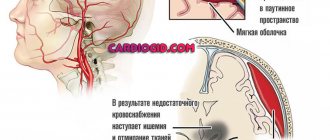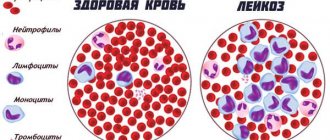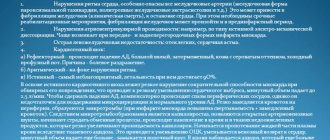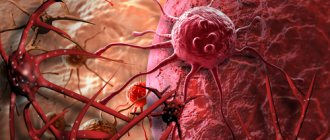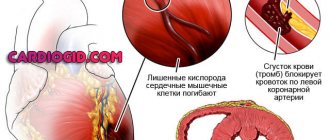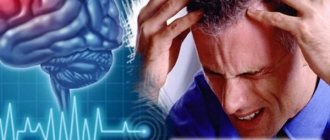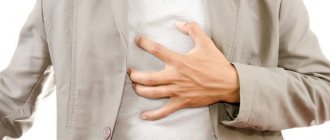A microstroke is a cerebrovascular accident that occurs as a result of blockage or damage to blood vessels in the brain. The so-called small stroke develops as a result of blocking the supply of oxygen to brain tissue.
The most important thing when a microstroke occurs is that the symptoms are completely reversible. The body is able to restore blood flow to the brain structures, in contrast to a major ischemic stroke.
That is, the vessel is covered with a not very dense mass. The resulting blood clot can be dissolved by the circulatory system’s own efforts. The dissolution of the blood clot occurs in a short time. Local disruption of the blood supply to the brain tissue.
Such a temporary disruption does not lead to massive death of brain cells. However, without careful attention to the situation, without eliminating the causes that created it, it may repeat itself. But if the disease relapses, irreversible consequences can occur.
Microstroke - what is it?
Attention. The term “ministroke” does not exist in the International Classification of Diseases. A pathological condition with these symptoms is officially referred to as a violation of cerebral blood flow.
Only this violation is transitory. That is, it is recoverable. And the pathology is abbreviated as TCI (transient cerebrovascular accident).
The disorder is accompanied by focal neurological signs. This phenomenon precedes a more serious illness such as a stroke.
The danger of a micro-stroke is that it is a harbinger of bigger problems. Moreover, among men of working age (from 20 to 54 years), PNMK is recorded in 25% of those who applied to clinics or were already hospitalized for examination or treatment.
According to statistics, it is also believed that a microstroke may represent the onset of a latent cerebrovascular disease.
To understand how a micro-stroke occurs, you need to understand that during an ischemic attack, the lumen of the artery is sharply blocked by a blood clot. The body independently removes the blockage, restoring healthy blood flow. Cerebral circulation normalizes within a few minutes, and the first signs of a microstroke disappear.
Acute oxygen deficiency, lasting several minutes, does not lead to the death of brain tissue. Therefore, after an attack, the first symptoms of a microstroke are quickly eliminated, the cells restore their activity without the development of neurological abnormalities.
It is possible to accurately verify the diagnosis only after several days have passed after the blockade. To do this, a computed tomography scan of the brain is performed, which reveals the presence of affected areas.
Manifestations of the disease depend on the location of the lesion in the brain. In the left-sided form, the activity of the right side of the body is disrupted. This form is diagnosed more often and is accompanied by impaired speech skills and intellectual abilities. With a right-sided stroke, speech is not impaired.
Consequences
If you consult a doctor in a timely manner and follow all instructions, the negative consequences are minimized.
At the same time, if you suffer an acute cerebrovascular accident on your legs, you may experience a series of repeated attacks within a short time. In the worst case scenario, ignoring symptoms threatens the further development of a major stroke. With the most unfavorable prognosis, it is fraught with a decrease in the quality of life and pathological changes in the functioning of consciousness.
Classification
Stroke belongs to the group of cerebrovascular pathologies. Small forms are differentiated into the same types as strokes. The category depends on the location of the lesion and the course of the disease. Types of microstrokes are hemorrhagic and ischemic.
Hemorrhagic attacks appear after a heart attack, atherosclerosis, arterial hypertension. The patient's face becomes numb, headaches increase, and difficulties with movement are recorded. This type is rarely diagnosed, but provokes irreversible consequences.
Ischemic stroke develops as a result of damage to brain cells due to the appearance of a blood clot. The cause of blockage of the vessel is a sharp increase in blood pressure, skull trauma, and stress.
Symptoms include headache and loss of consciousness. The condition returns to normal after a few hours. Ischemic forms include atherothrombotic, embolic and lacunar strokes.
How to diagnose
To find out whether there was a microstroke, the doctor only needs to study how the symptoms of the attack manifested themselves. The patient does not necessarily have to exhibit all the signs of pathology; 3-4 symptoms are enough to make a preliminary diagnosis, prescribe supportive therapy and refer the patient for additional tests. The results of laboratory and hardware examinations will provide detailed information about the state of human health.
Important information: How to get rid of hiccups after a stroke and the causes of its occurrence
Diagnosis of a microstroke includes determining the cause of the pathological process, location and size of the affected area.
The patient may be prescribed the following procedures:
- detailed blood test;
- X-ray examination of blood vessels (angiography);
- ECG (electrocardiogram);
- Dopplerography (ultrasound diagnostics that allows you to scan blood flow);
- echocardiogram;
- computed tomogram (CT);
- Magnetic resonance scanning (MRI).
To make a diagnosis and prescribe appropriate therapy, several specialists from different areas of medicine can be involved.
Micro stroke and stroke
A stroke is an acute disruption of blood flow to the brain due to arterial obstruction. This phenomenon provokes brain dysfunction. A minor stroke represents the same pathological condition, but with it the cumulative neurological effect persists for several days.
To understand how to recognize a microstroke, you need to differentiate a small type of stroke from a major one.
The first distinguishing feature is the time it takes the body to fight the resulting blood clot. In case of extensive hemorrhage, the clot is eliminated in about a day. During this period, brain structures atrophy due to lack of oxygen and nutrients.
The affected cells are not able to recover, which leads to the development of irreversible consequences: loss of vision, impaired speech skills, paralysis. 30% of patients die after a blood clot appears.
Attention! A microstroke is dangerous if it reoccurs. A relapse leads to the same serious complications as a stroke.
The second difference between a stroke and a microstroke is the nonspecificity of the minor symptoms. It happens that doctors sometimes mistakenly diagnose vegetative-vascular dystonia, believing that the patient has impaired vascular tone.
It is necessary to understand what a microstroke is, because the absence of treatment provokes irreversible consequences. This condition signals disruptions in cerebral blood supply and the development of ischemia.
Causes of microstroke
For reference. Among the anatomical disorders leading to stroke are blockage, spasm and rupture of the vessel.
Vascular obstruction appears due to narrowing of the lumen, which causes a decrease in blood supply and hypoxia. The vessel can be blocked by a plaque, metastasis, thrombus, or gas bubble.
If the capillary ruptures, a hemorrhagic type of disease is formed. Vasospasm occurs in hypertensive patients. Sudden changes in pressure lead to both stroke and other disorders of brain functioning.
A microstroke occurs as a result of exposure to causes that provoke the development of other cardiovascular diseases. Such reasons include hypertension, obesity, frequent consumption of alcoholic beverages, smoking, stress, and poor lifestyle.
Attention. Women taking combined oral contraceptives are prone to developing minor strokes.
There are risk factors that increase the likelihood of a blockade:
- cerebral atherosclerosis;
- heart disease, manifested in valve abnormalities, arrhythmias;
- arterial hypertension;
- diabetes;
- allergic vasculitis;
- osteochondrosis;
- apnea – stopping breathing during sleep;
- tumor neoplasms.
What causes a stroke
The main causes of stroke include pathologies of the cardiovascular system (arterial hypertension, arrhythmias, coronary heart disease and its complications, atherosclerosis of cerebral blood vessels), diabetes mellitus, old age, exposure to stress, physical and psycho-emotional stress, excess weight, unhealthy lifestyle (lack of sleep, overwork, poor nutrition, physical inactivity).
At what pressure a stroke occurs depends on the patient’s working blood pressure. Thus, in women with hypotension, a stroke can occur even with blood pressure that is considered low, for example, at 130/95 mmHg. Art.
The risk of stroke increases in women during pregnancy, especially in the case of its pathological course, with prolonged use of oral contraceptives, chronic migraines, polycystic ovary syndrome, mastopathy, and the presence of bad habits (smoking is especially dangerous over the age of 35).
The causes of hemorrhagic strokes include congenital changes in the blood vessels of the brain (aneurysms, arteriovenous malformations), and traumatic brain injuries.
Microstroke - symptoms
To understand how to identify a microstroke, you need to know its signs. The disease is diagnosed in both women and men of different ages, and the symptoms of a microstroke do not have gender differences. In men 18-40 years old, the disease is detected more often than in women of the same age category.
For reference. Signs of a mini-stroke in men are initially expressed in weakness and malaise, so many of them are not aware of the problem.
A common symptom of a microstroke of the brain is intense headache, which is the first sign of the disease in women. The pain cannot be eliminated with analgesic drugs. It can occur several times a day, accompanied by dizziness and nausea.
The patient notes loss of strength, drowsiness, and apathy. Blood pressure increases, breathing quickens, and heart pain increases.
For reference. Women tolerate minor strokes worse and require long-term rehabilitation.
Gradually the condition worsens, which is expressed in characteristic symptoms. Many people are interested in how to find out that there has been a microstroke. This is indicated by improper coordination of movements resulting from damage to the smallest capillaries.
The person often falls and has problems moving. This symptom clearly indicates brain dysfunction. There is excessive sweating, chills, photophobia, and the patient is irritated by loud noises.
With elevated blood pressure, hyperemia of the skin on the face develops. Uncharacteristic signs of the disease include shortness of breath, decreased hearing, thirst, hiccups, and chest pain. Some patients note an excited state and an increase in temperature.
The progression of the pathology leads to the appearance of characteristic symptoms, which requires urgent medical attention. Such manifestations include:
- numbness of the muscles of the face and limbs;
- unconscious state;
- loss of speech skills;
- memory gaps;
- vomit;
- vision problems.
Typically, symptoms of a mini-stroke can be noticed after sudden jumps in blood pressure. If you know how a stroke manifests itself, you can speed up the start of treatment. When starting therapeutic measures 3-5 hours after the attack, lost functions can be completely restored.
Early subtle signs of microstroke in women
Early neurological symptoms depend on which part of the brain is affected by the ischemic attack.
So, if the blood vessels of the parietal lobe are affected, there is a decrease or complete loss of tactile sensitivity . It is impossible to determine the characteristics of an object with closed eyes, it is impossible to determine whether it is cold or warm, what kind of surface it has, smooth or rough; What shape is it - square, round, triangular.
When the occipital lobe is damaged, ophthalmological problems : vision decreases, it is impossible to visually identify even well-known objects.
The manifestations of a microstroke are surprising when the temporal lobe is affected. There are lapses in memory and a feeling of “déjà vu” - “recognition of the past,” a mental state when a person “remembers” a place, situation or event.
Which pills are best for lowering blood pressure? Secrets of doctors!
The following are considered as common and earliest manifestations of microstroke in women:
- Semi-fainting conditions, accompanied by constant dizziness and severe headaches.
- Nausea, retching, or vomiting directly.
- Redness of the face and whites of the eyes.
- Characteristic tingling in the limbs.
A microstroke suffered on the legs - consequences
Many people suffer a micro-stroke on their legs without feeling any pathological changes. Signs of this condition may include mild weakness in the limbs and minor speech impairments.
The danger of this condition is expressed in the possibility of re-development of the blockade. A relapse leads to irreversible consequences or disability.
Attention. If an elderly person suffers a mini-stroke on his feet, then six months later a major ischemic stroke may be diagnosed. The disease leads to loss of sensory sensitivity and persistent paralysis.
Complications after a ministroke
To understand how a microstroke progresses and what complications it causes, it is necessary to assess the degree of damage to brain structures, find out the patient’s age and the presence of concomitant diseases. With mild damage to the capillaries, the patient’s rehabilitation does not take much time.
Attention. According to statistics, 10% of people who have undergone a minor blockade develop myocardial infarction over time. 30% of patients have a stroke 5 years after the blockade.
When the disease develops in old age, against the background of problems with the cardiovascular system, the following complications develop: increased irritability, deep depression, deterioration of intellectual abilities, systematic pain in the head.
Attention. The most serious complication is the occurrence of an ischemic attack of the brain or stroke 3 days after the micro-attack. Such pathologies often lead to death.
Signs
As with ischemic stroke, clinical manifestations consist of focal symptoms and general cerebral disorders. Therefore, they can be divided into several groups:
- general cerebral – sudden acute headache or gradually increasing, general weakness, nausea, vomiting, brief episodes (sometimes imperceptible) loss of consciousness;
- vegetative – hot flashes, redness of the upper half of the body, sweating, cold hands and feet, muscle tremors;
- carotid (spasm or blockage in the area of the carotid artery) - decreased sensitivity (numbness) or tingling of the skin of the arms and legs, half of the face, weakness in the arm or leg, speech impairment, short-term blindness in one eye, convulsions;
- vertebral arteries - dizziness, noise in the head, unsteadiness when walking, flashes of light in the eyes, disturbance of the outlines of objects, loss of part of the visual field, double vision, loss of clarity of speech, difficulty swallowing, headache and dizziness may increase when turning (tilting) the head ;
- stem part - severe dizziness, impaired eye movements, loss of vision and hearing, loss of balance, swallowing and sensitivity in a limited area of the face, difficulty pronouncing words;
- medulla oblongata – brief loss of the ability to move (“freezing in one position”);
- temporal lobes – loss of orientation in space and time, inability to reproduce current events.
Sometimes there is a combination of two or more groups of characteristics. Such an attack can last from a few minutes to 8 - 10 hours. The next day the patient feels satisfactory, or severe weakness remains.
Diagnosis of microstroke
The dominant method for diagnosing any disruptions in cerebral blood supply is magnetic resonance imaging.
For reference. MRI for microstroke allows you to evaluate brain tissue and identify even initial changes in the tissue. MRI diagnostics monitors the regression of the affected lesion over time.
Since MRI is one of the least accessible methods of examination, it is used only in serious cases, after certain tests have been carried out. Initially, the patient is examined by a neurologist, assessing the condition of reflexes and muscles.
It is necessary to determine the concentration of cholesterol and measure the pressure - the values will be high. A high blood clotting rate indicates an increased risk of blood clots in the choroid plexuses of the brain.
For reference. As another diagnostic method, a positron emission study is used, which detects an ischemic focus even before its formation begins.
It is also necessary to examine the vessels for the presence of blood clots and plaques. If they are detected, it is recommended to eliminate the formations through surgery.
Providing first aid for a microstroke
If it is impossible to quickly call a doctor, follow this algorithm:
- The patient is placed in bed, providing unhindered access to fresh air.
- They give you a tablet of Aspirin, Agrenox or, if they are intolerant, Clopidogrel.
- To improve blood flow and protect brain neurons, give piracetam or Vinpocetine.
- Blood pressure is measured, and if its first number exceeds 200, it is slowly lowered. Furosemide or Captopril are used.
- In diabetes mellitus, glucose levels are reduced.
St. John's wort, health benefits and harms after 50 years
For micro-strokes, do not take popular painkillers containing caffeine (Citramon), as they increase blood pressure even more.
Check out the list of the best blood pressure pills.
How to detect a microstroke at home
The first manifestations of coronary artery disease are usually noticed at work, at home, or on the street. To verify the signs of an extensive microstroke, you can carry out a number of indicative checks before the ambulance arrives.
Attention. The first thing you need to pay attention to is the victim’s smile. When asked to smile, you may notice asymmetry in the corners of the mouth.
The person begins to speak indistinctly, lexical units and sentences are pronounced slowly and unclearly. There are problems with raising the limbs: the patient will not be able to raise his arms in parallel due to a blockage of the blood supply to the brain.
Microstroke - treatment
To fully restore the functioning of the brain, it is necessary to begin therapeutic measures as early as possible. Therefore, the first steps to provide emergency assistance are important.
First aid
Before the ambulance arrives, you need to lay the victim down with his head turned to the side. This will help prevent vomit from entering the airways when the gag reflex appears.
It is recommended to cover your head with a damp towel and place a pillow under it. An elevated posture reduces the intensity of the development of cerebral edema, since this reduces the volume of accumulated fluid.
It is necessary to ensure a flow of fresh air. The person should be freed from constrictive clothing and the buttons should be unbuttoned. It is prohibited to move the patient. You need to ensure a calm state and wait for medical help.
As first aid for a microstroke, you can constantly maintain a conversation with the victim. This will calm him down and give him confidence in a speedy recovery.
For reference. The ability to talk to the patient distinguishes the minor form from other severe disorders, when a person is resuscitated, maintaining vital functions.
Drug therapy
The ideal option to start treatment is the first painful signs. This period is characterized by the most favorable prognosis. Due to the mild severity of the symptoms, treatment measures begin later - which is why a micro-stroke is dangerous.
The following medications are used to treat disruptions in cerebral circulation:
Thrombolytics. The products eliminate blood clots, restoring healthy blood flow. Medicines have a therapeutic effect only for 3 days after the blockade. In hemorrhagic form, such drugs cause irreparable harm.
Disaggregants - Dipyridamole, Aspirin. The drugs help thin the blood. Anticoagulants – Fraxiparine, Fragmin. Prevents blood clotting by preventing the formation of blood clots.
Diuretics. Eliminate swelling of the brain structures, preventing the affected areas from wedging into the back of the head.
Neuroprotectors. They represent a large group of medications that support brain cells during the rehabilitation period.
Antihypertensive drugs. They are used to reduce blood pressure during the treatment and recovery phase.
For reference. To improve the therapeutic effect, the patient must fully follow the doctor’s recommendations and regularly take prescribed medications.
Rehabilitation period
The patient’s recovery after the blockade includes physical therapy, physiotherapeutic procedures, massage, diet correction, and swimming. The patient is referred to a rehabilitation specialist, speech therapist, and neurologist. Sanatorium treatment is also indicated.
A person must change the menu and normalize weight. It is necessary to avoid spicy, salty, fatty and smoked foods. It is recommended to enrich the diet with high-calorie foods containing a high concentration of vitamins and nutrients. This will help the cardiovascular system recover faster.
For reference. If the patient persistently follows the rules of the rehabilitation program, this will return his lost health and lost skills. The risk of relapse will also be reduced.
Prognosis and prevention
The prognosis after a mini-stroke depends on the factor that provoked the attack. If the cause is stress or obesity, then fighting the provocateur guarantees a complete recovery. In case of an ischemic attack resulting from a disease, a specific therapeutic regimen is required.
To prevent the formation of blood clots, you need to know the rules for preventing micro-strokes. The primary task is to quit smoking, excessive alcohol consumption and other bad habits. You should eat a lot of fresh vegetables, fruits, foods containing fiber, and vitamins.
Advice! A prerequisite for prevention is to avoid stress and emotional stress.
The dominant preventive action against transient ischemic attack is blood pressure control. After all, high blood pressure during a microstroke is the main cause of the disease.
It is recommended to regularly engage in feasible physical activity. Exercises keep the muscular system in good shape, preserving the function of cerebral vessels.
How to avoid a stroke or its recurrence
You can prevent a stroke or, if it has already happened, a relapse, by taking prevention seriously. The main method of prevention is improving lifestyle. This concept includes a balanced diet, giving up bad habits, correcting excess body weight, sufficient physical activity, controlling blood pressure, getting enough sleep at night, and avoiding stress.
A healthy lifestyle is the basis of both primary and secondary prevention of strokes
If a mini-stroke or stroke occurs, it is important to undergo a course of drug therapy aimed at improving cerebral circulation and to be regularly monitored by a doctor. Effective rehabilitation, as well as prevention of possible relapses, is sanatorium treatment.


